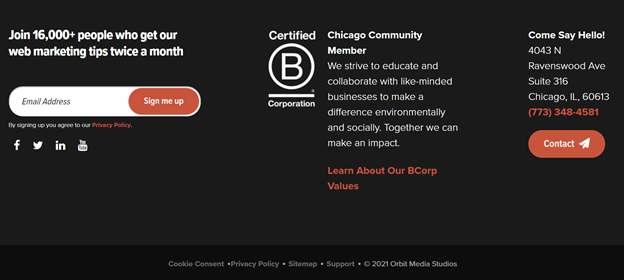What is a Footer?

So, what is a footer? Web footers are powerful navigational tools and contain essential information like disclaimers, contact details, and more. Creative web footer ideas are abundant on the internet. There are templates of different designs and colors to choose from. However, creativity is not always appreciated in design. Sometimes, creativity can also be shown in the content of the web footer. Let’s all learn what we can creatively include in web footers.
What to put in a Web Footer?
Web footers are almost invisible. They are written in small letters with font colors that almost match the backgrounds. These are found at the bottom of the website. However, web footers are powerful navigational tools and contain essential information like disclaimers, contact details, and more.
If you are unsure what to put in your web footers, there are a ton of options. However, let’s look here for the basics:
- Sitemap
- Privacy Policies and disclaimers
- Terms of Use
- Contact details
What else can we put in a Web Footer?
It has been well established that web footers are almost invisible but are essential elements of a website. But it does not have to be boring, you can get creative in your blog and add in surprising but helpful elements in your web footers. Here are some examples:
A subscription button
When creating a brand, such is the case in developing a blog, brand following and loyalty is the best way to stimulate a good traffic flow. Many bloggers do this through subscriptions. Upon inspecting the footer of this website, there is a ‘sign-up’ bar that is easily accessible for readers. To subscribe, they simply have to supply their emails and click the “sign me up” button. This ease and accessibility to the subscription button is a good way of enticing readers to subscribe to your blog and content.

Summary of Content
One thing to remember about a web footer is that similar to the menu bar, it is a navigational tool for readers. If they want to get back to older content without going through every page of the blog, they can simply look through the content summary at the bottom of your blog. It does not have to be too detailed, but just informative enough to lead them to what the readers are looking for.

Content Search
This is another interesting and creative idea for your web footer – content search. What if you have new readers that would like to look through your older content for specific subject matters? The content search will be great for that. Just like in this web footer from the CNN website that has TONS of content for readers to search through, a simple search button is enough to help them navigate through content.

About button
In older websites and blogs, the About button was a basic part of web footers. However, bloggers now incorporate it in the menu bar instead. However, it is still a creative idea to re-incorporate it in the web footer in case the readers want to know about the platforms, themes, and topics that a blog is about. Just like in this example, the website owner incorporated the About button in a ‘no-frills, just chills’ minimalist web footer design.

A direct statement of privacy policies and disclaimers
If your blog niche is more susceptible to legal issues (like advise blogs, tutorial blogs, or websites that require personal information), disclaimers and privacy policies are HIGHLY IMPORTANT. This is why certain websites choose to highlight important articles in their disclaimers and policies directly on the web footer. This helps readers get that important legal information easily. In the example below, the website has clearly stated its disclaimers for accessibility accommodations. The website has also included their licenses on the web footer.

Socials
Bloggers should know that when readers follow on social media, it already counts as a form of subscription. Not many people read their emails often and are easier to reach via social media. This is why it is also important to give readers options when it comes to subscriptions. Remember, brand following and loyalty will stimulate re-visits and are, in turn, consistent internet traffic.
The web footer example below did a simple approach to introducing their socials by using black and white icons. These icons serve their purpose but still match well with the aesthetics of the blog.

Credits or “Meet the Team”
This is one addition that many bloggers usually forget. Always give credit to “The Team”. It could be your web designer, your web developer, your graphics designers, and more. It is good exposure for their individual careers and portfolios as well. Also, followers of these designers and artists could also start following your blog.

The Copyright
Some websites, just like ours, include all the basic elements of a web footer directly on the menu bar. In that case, it makes a cleaner and sleeker aesthetic to the website. In this case, the Copyright statement may be enough for a web footer.

In any case, no web footer at all
A lot of blogs and websites do not follow the “standard” layout of web design anymore. Sometimes they take a much more artistic and interactive approach to website design. In this case, having a web footer may not be necessary.
Take a look at this interactive website below:

Also Read: How to Write the Best Email Newsletter
Civil Engineer by profession, Writer by passion. Serving readers since 2014 on different niches like Science, Current Events, Tech, and Travel.

